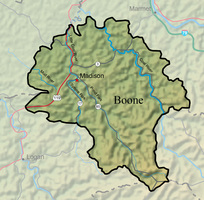
Boone County was formed March 11, 1847, from parts of Logan, Kanawha, and Cabell counties by an act of the Virginia legislature. It is located in the southern coalfields of West Virginia. It has an area of 503.2 square miles. Madison is the county seat, originally known as Boone Court House. Boone County was named for Daniel Boone, who lived in the neighboring Kanawha Valley in the late 18th century.
The topography is typical of the Allegheny Plateau, mountainous with little bottomland. Elevations vary from a low of 660 feet in the north to nearly 3,400 feet in the southeast. The land is heavily forested and rich in mineral resources. Boone is drained primarily by the Coal and Little Coal rivers, which converge outside the county and flow to the Kanawha River below Charleston.
The first permanent European settlements in present Boone County were likely made in the 1790s, though numerous explorers and hunting parties had previously visited the area. John Peter Salling, exploring in the region in 1742, discovered the coal deposits for which Coal River was named and which have provided generations of Boone Countians with their livelihood.
Prior to the Civil War, the young county remained sparsely populated and agricultural, with an 1850 population of 3,149. No major military actions occurred in the county during the Civil War, but there were numerous skirmishes and guerrilla raids. The population was divided in its loyalties, though most Boone County voters preferred secession when the question was put before Virginians in a May 1861 referendum. The 1860 census shows that out of about 750 families only 36 owned slaves. The first courthouse was burned by Union soldiers in September 1861 after a skirmish with Southern-sympathizing militia. The courthouse was not rebuilt until after the war.
Timber was the first major industry to come to Boone County, in the 1870s. Early timber companies included the W. M. Ritter Lumber Company, D. F. Mohler and Sons, Coal River Mining & Lumber Company, and the Boone Timber Company. Originally, the logs were floated down to mills on the Kanawha, and the industry expanded with the later arrival of the railroad. In 30 years the forests of Boone County were largely depleted. Today there are no stands of old-growth forest remaining, but logging remains important as second- and third-growth timber is taken from the county.
Boone County was one of the few places in Western Virginia where large-scale coal mining was undertaken before the coming of the railroad. Navigational improvements were made to the Coal River in the late 1850s, and substantial amounts of the region’s valuable cannel coal were mined and shipped before these river improvements were largely lost in the great flood of 1861. The mining industry expanded greatly with the coming of the railroads after 1900. Coal quickly became the county’s primary economic engine and major employer, with most other industries supporting the work of the mines.
The conditions under which the early miners worked were often less than satisfactory and sometimes brutal. This led to a series of labor-management conflicts known as the West Virginia Mine Wars. Boone County’s part in the labor uprising was not as great as that of some surrounding counties, but several major events occurred in the county. During the 1921 armed miners’ march, the striking miners twice gathered in Madison on their way toward Logan and Mingo counties. After the second meeting they continued south to confront Logan Sheriff Don Chafin’s forces at the Battle of Blair Mountain on the Boone-Logan border. It was estimated that as many as 20,000 miners marched through Boone County to reach the battleground.
In recent years the number of miners has declined as mechanization and the shift to surface mining have reduced the need for labor. The Boone County population shrank from 33,173 in 1950 to 25,118 in 1970, then rose during the energy crisis to 30,447 in 1980. The population was an estimated 24,478 in 2012 and 21,809 in 2020. The number of coal miners employed in Boone County fell from 4,948 in 1950 to approximately 2,000 in 2010, and 654 in 2022.
Coal extracted increased from approximately 6 million tons in 1950 to more than 32 million tons in 2000, declined to 26 million tons in 2009, and then fell dramatically to 3.8 million tons in 2022, making the county West Virginia’s ninth leading coal producer. During the same period, the amount of surface mined coal increased from approximately 7 million tons in 2000 to 16 million tons in 2009 before dropping below one million by the 2020s. Although Boone County no longer leads West Virginia in coal production, mining remains central to its economy and psyche.
The 1980s saw Boone County grow closer to Charleston with the completion of four-lane Corridor G (U.S. 119) from Madison to Charleston. Many residents began to commute to the Charleston area to work. These changes have been accompanied by a concerted effort to diversify the local economy, most notably in the field of tourism through the creation in the early 1980s of the Water Ways water park and the opening of the Hatfield-McCoy Trail for all-terrain vehicles in 2002. As of 2022, only one of Boone County’s top 10 largest employers was directly related to coal mining. The top five were, respectively, the county school system, Blackhawk Mining, Boone Memorial Health, Loved Ones in Home Care, and Hillcrest Health Care Center.
This Article was written by John E. Adkins
Last Revised on December 21, 2023
Related Articles
Sources
Boone County. Madison: Boone County Genealogical Society, 1990.
Cite This Article
Adkins, John E. "Boone County." e-WV: The West Virginia Encyclopedia. 21 December 2023. Web. 26 July 2024.




Comments?
There aren't any comments for this article yet.
Click here to read and contribute to the discussion →